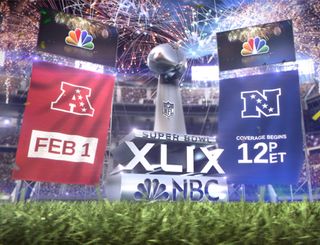NBC Seeks Touchdown On Biggest Production

The teams and the viewers aren’t the only ones looking forward to Super Sunday with great expectations. Super Bowl XLIX on Feb. 1 is anticipated to be not only the biggest TV ratings and advertising extravaganza of the year (as usual), but it will also put a spotlight on some of the latest and greatest live sports production technology features on the planet.
“We will have all the next generation technology and the new production trucks at the stadium for the big game,” says George Hoover, CTO of the mobile production company NEP—which in this case means 27 trailers to NBC and various other channels to produce the game and a variety of events leading up to the match-up between the Seattle Seahawks and the New England Patriots.
NBC Sports Group will be using some 18 mobile production units, 11 office trailers, eight Avid edit suites, two Final Cut edit suites, 500-plus staffers on game day, 86 cameras and about 33 miles of cabling for the production of the big game and related events.
“NBC has secured more than 600 hotel rooms to accommodate talent, production staff, engineers, scenic and lighting personnel over a two-week period,” says Ken Goss, senior VP of remote operations and production planning for NBC Sports.
Greater use of slow-motion and specialty cameras will provide one of the most notable visible areas of improvement over regular-season productions. “We typically use 34 slow-motion cameras for Sunday Night Football,” explains Goss, who adds that they will be adding 12 more for a total of 46 Grass Valley LDX and Sony 3300 cameras.
NBC Sports will also be putting “4K cameras covering the goal lines” and is deploying Evertz’s Dreamcatcher systems “to record and zoom in on the action quickly for instant replays,” he says.
Rapid Replays
Broadcasting & Cable Newsletter
The smarter way to stay on top of broadcasting and cable industry. Sign up below
Other notable tech improvements from NBC’s last Super Bowl production in 2012 include NEP’s new ND1 mobile production unit, an expanded roster of EVS replay technologies and tighter integration between the stadium and NBC Sports Group’s International Broadcast Center in Stamford, Conn., so they can draw on additional talent and resources.
“It will enable them to tell the story of the game as fast as possible with the best camera angles and the best quality of high-speed camera playback,” says James Stellpflug, EVS VP.
A key part of that will be NEP’s new production truck ND1, which has been used all season for NBC’s Sunday Night Football, and is now making its Super Bowl debut. It is equipped with the powerful new Grass Valley Kayenne K-Frame Elite Switcher; better networking capabilities for quickly moving content; and a new EVS infrastructure for replays.
For the game, NBC will be using 19 EVS XT3 servers, two EVS Spot Box XT3s, the EVS’ IPDirector for asset management, ingest control, metadata and playout and its XFile3 system for fi le transfer and archiving to and from the NBC Sports center and the stadium.
Hoover at NEP notes that the truck was designed to allow NBC staff working out of Stamford to quickly access content in the truck and to provide much faster networking. “The EVS servers are running on 10GB networking between the servers so we can more efficiently create replays and get more replays on the air,” he says.
Other key tech providers include Evertz for the EQX Router (1207x1080); Grass Valley, which is providing both the LDX cameras and the production switcher for the ND1 mobile truck; and Ross Video, which is supplying systems for displaying virtual graphics and artwork from the goal post cameras.
In terms of editing, NBC will using eight editing suites from Avid and two with Apple’s Final Cut Pro.
Avid is also supplying the Avid MediaCentral Platform workflow system, which NBC has used in the past for the Olympics and a number of other top events. The system will help streamline workflows and make it easier for teams in Stamford and at the stadium to collaborate and share content.
For audio, NBC plans to be using the Calrec Apollo Digital Audio Console and over 100 microphones from Sony, Sennheiser and Audio Technica.
To shoot the event, NBC will be heavily relying on Canon for lenses, and on Sony, which will provide 45 of its HDC-2500 cameras as well as a number of high-frame-rate HDC 3300 cameras.
SUPER BOWL STREAMS FOR TVE
Three years after NBC became the first broadcaster to live-stream the Super Bowl, the network is hoping to break new ground by using the 2015 live-stream to promote its new TV Everywhere offering, providing 11 straight hours of streaming NBC content without requiring users to log into the system. “We are doing a lot of things to make it easier to access the content and to boost the awareness of TV Everywhere,” says Eric Black, VP of technology at NBC Sports Group.
With the stream expected to produce super-sized traffic—the 2012 effort drew some 2.1 million uniques—NBC Sports is working with several main tech providers, including Microsoft for cloud-based encoding, Akamai for distribution and security, and Adobe, which is supplying technology from its Primetime offering for managing and delivering video content. Freewheel will also be providing technologies for dynamic ad insertion because the digital stream will carry different spots than the linear TV feed.
